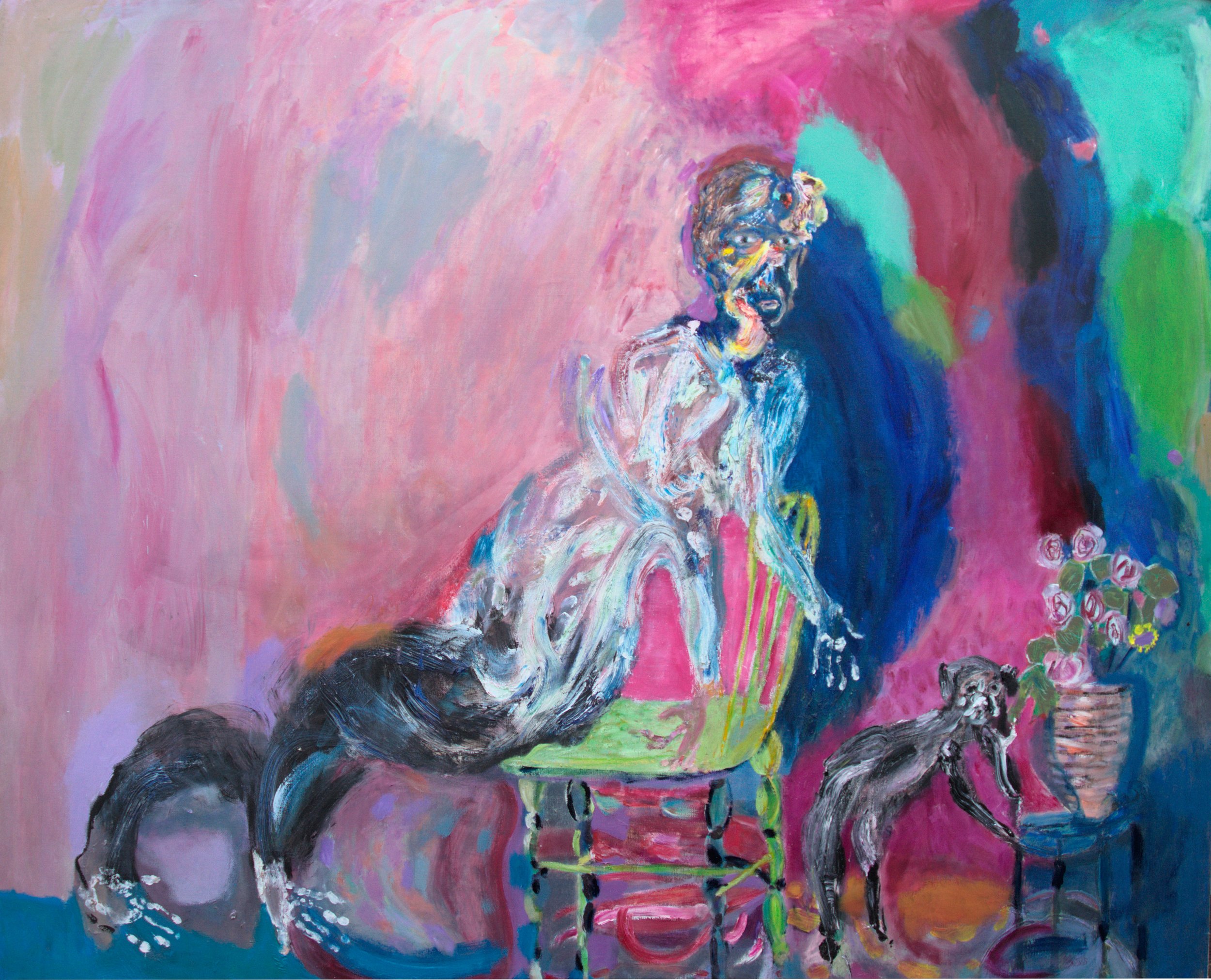Resolving from the Inside
An Interview with Andrew Litten
For the Newlyn Society of Artists Exhibition Engage
Initially, the marks are physical and very quick, as I need to physically connect with the work. This is followed by more thoughtful, slow stages. I allow the work to gestate for many months, allowing it to dwell in my mind and a way forward to become clear.
The walls of Andrew Litten’s house are covered in paintings. He leads me through kitchen into his conservatory. We are greeted by his black cat, Evie, who chirrups a friendly meow and looks up expectantly at me. I go to stroke her, but she scuttles away. ‘She’s a bit of a scaredy cat with strangers, it’s usually just me and her in the house.’
The conservatory is dominated by two enormous paintings. Impasto curls of paint make up two lyrical figures. A boy stands on a blue-tinged beach in the shadow of a benevolent horse. In the other, purples, pinks and blues pulse, revealing a figure leaning to stroke a dog. The two figures in each painting are created with a light, melodic touch, resulting in pieces that teeter between strangeness and beauty.
Andrew coaxes me back to his light-filled dining room and introduces me to his piece, A Quiet Collapse, which at 50 x 60 cm is much smaller than the huge canvases in the conservatory but no less powerful. We curl ourselves round our cups of tea, warming ourselves up from the windswept Cornish weather and I begin the interview.
KRE: Can you talk to me about the piece you have created for the NSA ‘Engage’ Exhibition?
AL: It’s called ‘A Quiet Collapse,’ which shows a person having a fraught internal dialogue.
Initially, I wanted to do a larger painting, as I have been working on a big scale for
some time, but it quickly became clear that there would be a contradictory dialogue between looking through a small phone at a large painting.
I have collaborated with Tanya on developing an augmented reality animation of the piece, which the viewer will see when looking though their phone. As my paintings have a rawness to them, I wanted to try and keep the emotive feeling of the piece in the animation. I settled on something that could feel raw and disturbing rather than full of digital effects.
The overlayed animation is subtle. The dog’s tail wags idly, the figures to the side of the sofa slowly disappear behind and under it. The effect is playful, almost funny in some respects, but the slowness of movement and the clear distress of the figures makes this contrast more aberrant.
KRE: What do you think the AR element brings to the piece?
AL: I wanted to make sure the digital effects did not distract from the sensation of the painting, the this added media would create a dialogue in keeping with the work. So, I decided it would be best if I kept it really simple, rather than using dazzling digital alterations. For me, this piece is about loss, so the movement of the heads is to do with transience. It creates an impression of impermanence: I wanted a sense of change and movement in the piece to reflect this.
KRE: What have you enjoyed about exploring Augmented Reality?
AL: As a self-taught artist, I quite like the directness of exploring new media in an interesting way. It provided a new challenge and has the potential to expand the artists toolbox. The timeframe limitations meant this is potentially only a starting point for many of the artists exploring it, which I why I wanted to keep it simple. I embraced the potential directness of it.
I ask to see Andrew’s studio space. He shows me through to a room at the back of the house. It is an explosion of industry. Every inch of wall space is covered with more enormous paintings, even the corners are layered with un-stretched canvas.
KRE: Can you talk to me about your process?
AL: I have a huge back catalogue of early work and I will use this as a starting point. I will alter older ideas to make them come to life in a new way. I am also prompted by books and music; very often conversations with people will bring new life to an image. I pin canvas to the corners like this to get interesting perspectives in the work. Initially, the marks are physical and very quick, as I need to physically connect with the work, resolving it from the inside. This is followed by more thoughtful, slow stages. I allow the work to gestate for many months, allowing it to dwell in my mind and a way forward to become clear. I have no set process for the way I work, it’s always intuitive and exploratory so I never really know where it is going. It’s guided by the emotive content.
A black form catches the corner of my eye; Evie has come to collect us from the studio. Andrew kindly takes me to the train and we talk about his upcoming shows in London and St Ives. There is a warmth and gentility that comes from Andrew which somewhat contrasts to the power and rawness of his work. It is work of pain and loss but also that of new beginnings, beauty and sensuality.



